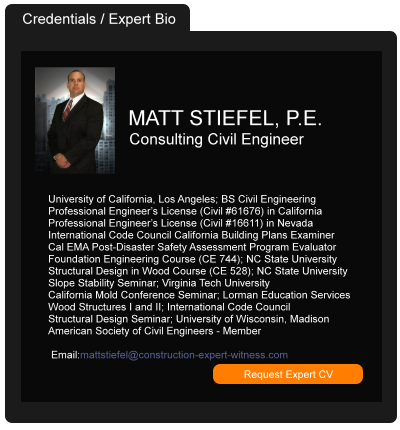Texas Allows Wide Scope for Certificate of Merit
January 07, 2025 —
Lian Skaf - The Subrogation StrategistThe purpose of certificate of merit (sometimes referred to as affidavit of merit) statutes is to identify frivolous claims before the court wastes time and resources during litigation. More common in medical malpractice cases, several states have enacted similar requirements for professional negligence claims dealing with construction-related issues. While a subrogation attorney should not be bringing a frivolous case to suit anyway, the requirement adds another step in the process that plaintiffs need to properly navigate.
Chapter 150 of the Texas Civil Practice and Remedies Code requires that in an action arising out of professional services by a licensed or registered professional, claimants must file an affidavit from a qualified expert attesting to the theories of recovery, the negligence and the factual basis for the claims. The expert must be competent, have the same professional license or registration as the defendant and practice in the area of practice of the defendant.
In Janis Smith Consulting, LLC v. Rosenberg, No. 03-23-00370-CV, 2024 Tex. App. LEXIS 7961, the Court of Appeals of Texas, Third District (Court of Appeals) addressed a challenge from the defendant as to the sufficiency of the plaintiff’s certificate of merit in an interlocutory appeal. The Court of Appeals affirmed the lower court’s dismissal of the defendant’s motion to dismiss based on the allegedly improper certificate of merit, holding that the plaintiff’s expert was sufficiently qualified to certify the legitimacy of the case.
Read the court decisionRead the full story...Reprinted courtesy of
Lian Skaf, White and Williams LLPMr. Skaf may be contacted at
skafl@whiteandwilliams.com
The Future of Construction Work with Mark Ehrlich
February 19, 2024 —
Aarni Heiskanen - AEC BusinessIn this episode of the AEC Business
podcast, I had the pleasure of speaking with Mark Ehrlich, a veteran of the construction industry from the USA and the author of “The Way We Build: Restoring Dignity to Construction Work.” Our conversation delved into the evolving landscape of construction work and the challenges faced by construction workers today.
Mark shared his extensive background, starting as a carpenter and rising through the ranks to become the head of a 25,000-member union organization. His experience spans decades, and he has authored three books and numerous articles on labor issues.
The historical labor shifts
We discussed the historical shift from a predominantly unionized construction workforce to the current bifurcated system in the US, where union strongholds in the north contrast sharply with the non-union, lower-wage environments in the south and other regions. Mark highlighted the issues of wage theft, declining safety standards, and the exploitation of undocumented workers.
Read the court decisionRead the full story...Reprinted courtesy of
Aarni Heiskanen, AEC BusinessMr. Heiskanen may be contacted at
aec-business@aepartners.fi
California Assembly Bill Proposes an End to Ten Year Statute of Repose
May 09, 2011 —
CDJ STAFFCalifornia Assemblyman Furutani has introduced a bill that if passed would eliminate the ten year statute of repose in certain construction defect cases. The statute of repose would not apply when “an action in tort to recover damages for damage to real or personal property, or for personal injury or wrongful death from exposure to hazardous or toxic materials, pollution, hazardous waste, or associates environmental remediation activities,” according to the latest amended version of AB 1207.
�When Furutani first introduced the bill, it was aimed at small businesses only. However, the description of the bill, which read, “An act to amend Section 14010 of the Corporations Code, relating to small businesses” has been stricken from the bill, and it has been amended to read, “An act to amend Section 337.15 of the Code of Civil Procedure, relating to civil actions.”
�The change in the bill’s intent has caused some outcry among attorneys in the blogosphere. For instance, Sean Sherlock of Snell & Wilmer stated that “the proposed amendment is unnecessary, and would upset nearly 50 years of deliberative legislation and judicial precedent on construction defects liability and the 10–year statute — all apparently motivated by a decision in a single, isolated Superior Court lawsuit that has not yet been reviewed by the court of appeal.” Sherlock is referring to Acosta v. Shell Oil Company, in which the Superior Court agreed to dismiss the plaintiffs’ claims against the developer based in part on the ten year statute of repose. AB 1207 was amended five days after the ruling in Acosta v. Shell Oil Company.
�California AB 1207 has been re-referred to the Judiciary Committee.
�Read the full story…
Read the court decisionRead the full story...Reprinted courtesy of
Guessing as to your Construction Damages is Not the Best Approach
November 18, 2019 —
David Adelstein - Florida Construction Legal UpdatesArbitrarily guessing as to your construction damages is NOT the best approach. Sure, experts can be costly. No doubt about it. Having an expert versus guessing as to your construction damages caused by another party’s breach of contract is a no brainer. Engage an expert or, at a minimum, be in a position to competently testify as to your damages caused by another party’s breach of contract. Otherwise, the guessing is not going to get you very far as a concrete subcontractor found out in Patrick Concrete Constructors, Inc. v. Layne Christensen Co., 2018 WL 6528485 (W.D. New York 2018) where the subcontractor could not competently support its delay-related damages or change orders and, equally important, could not support that the damages were proximately caused by the general contractor’s breach of the subcontract.
In this case, the concrete subcontractor entered into a subcontract to perform concrete work for a public project. The project was delayed and the general contractor was required to pay liquidated damages to the owner. Not surprisingly, the subcontractor disputed liability for delays and sued the general contractor for all of its delay-related damages “in the form of labor and materials escalation, loss of productivity, procurement and impact costs, field and home office overhead, idle equipment, inability to take on other work, lost profits, and interest.” Patrick Concrete Constructors, 2018 WL at *1.
The general contractor moved for summary judgment as to the plaintiff’s delay-related damages – the subcontractor’s damages were nothing but guesses and the subcontractor could not prove the general contractor was the cause of the subcontractor’s damages.
Read the court decisionRead the full story...Reprinted courtesy of
David Adelstein, Kirwin Norris, P.A.Mr. Adelstein may be contacted at
dma@kirwinnorris.com
The Quiet War Between California’s Charter Cities and the State’s Prevailing Wage Law
April 20, 2016 —
Garret Murai – California Construction Law BlogBehind the scenes a quiet war is raging.
A war pitting local sovereignty, on one hand, against a Depression-era law intended to help those working on state and local public works projects, on the other.
California’s Prevailing Wage Law
Beginning in 1929 and continuing through the late 1930s, the Great Depression is widely considered to be the longest, most widespread depression of the 20th century. In 1931, the federal government enacted the Davis-Bacon Act to help workers on federal construction projects. The Davis-Bacon Act, also known as the federal prevailing wage law, sets minimum wages that must be paid to workers on federal construction projects based on local “prevailing” wages. The law was designed to help curb the displacement of families by employers who were recruiting lower-wage workers from outside local areas.
Read the court decisionRead the full story...Reprinted courtesy of
Garret Murai, Wendel Rosen Black & Dean LLPMr. Murai may be contacted at
gmurai@wendel.com
Travelers’ 3rd Circ. Win Curbs Insurers’ Asbestos Exposure
May 03, 2017 —
Gregory D. Podolak - Saxe Doernberger & Vita, P.C.In breaking news this week, LAW360.com posted that the Third Circuit ruled Friday that “a common exclusion found in a Travelers policy bars coverage for claims arising out of asbestos in any form, limiting insurers’ potential exposure to asbestos injury claims by precluding policyholders from arguing that the exclusionary language is ambiguous and doesn’t extend to products containing the carcinogen.”
In its detailed analysis of the decision, LAW360 turned to Greg Podolak for his analysis.
Gregory D. Podolak, managing partner of Saxe Doernberger & Vita PC’s Southeast office, said the ruling is a cautionary tale that should galvanize policyholders and their insurance brokers to take a closer look at policies to delete or curtail broad “arising out of” language in exclusions. Otherwise, insureds could find themselves without any coverage for claims even remotely related to a certain product, he said.
Read the court decisionRead the full story...Reprinted courtesy of
Gregory D. Podolak, Saxe Doernberger & Vita, P.C.Mr. Podolak may be contacted at
gdp@sdvlaw.com
Endorsement to Insurance Policy Controls
March 28, 2022 —
David Adelstein - Florida Construction Legal UpdatesI’ve said this before, and I’ll say it again: an insurance policy is a complicated reading and this reading gets compounded with endorsements that modify aspects of the policy.
What you think may be covered may in fact not be covered by virtue of an endorsement to the insurance policy. This is why when you request an insurance policy you want to see the policy PLUS all endorsements to the policy. And when you analyze a policy, you need to do so with a full reading of the endorsements.
An endorsement to an insurance policy will control over conflicting language in the policy. Geovera Speciality Ins. Co. v. Glasser, 47 Fla.L.Weekly D436a (Fla. 4th DCA 2022) (citation omitted).
The homeowner’s insurance coverage dispute in Glasser illustrates this point. Here, the policy had a water loss exclusion. There was an exception to the exclusion for an accidental discharge or overflow of water from a plumbing system on the premises. But there was an endorsement. The endorsement modified the water loss exclusion to clarify that the policy excluded water damage “in any form, including but not limited to….” Examples were then given which did not include the accidental discharge or overflow of water from a plumbing system.
Read the court decisionRead the full story...Reprinted courtesy of
David Adelstein, Kirwin Norris, P.A.Mr. Adelstein may be contacted at
dma@kirwinnorris.com
Manhattan to Add Most Office Space Since ’90 Over 3 Years
June 18, 2014 —
Jonathan LaMantia – BloombergManhattan is poised to add the most office space in any three-year period since 1990 as projects including buildings at Hudson Yards and the World Trade Center site are completed, the New York Building Congress said.
The borough, home to the largest U.S. office market, probably will add 9 million square feet (836,000 square meters) of office space at nine development sites from last year through 2015, according to the organization, which promotes construction in the New York City area. An additional 10 million square feet at six buildings is likely to become available from 2016 through 2018, the group said in a statement today.
“It’s a vote of confidence in the market, which we think is long overdue,” Richard T. Anderson, president of the New York Building Congress, said in a telephone interview. “As a global center of finance and office-related functions, the city needs to regenerate its office space.”
Read the court decisionRead the full story...Reprinted courtesy of
Jonathan LaMantia, BloombergMr. LaMantia may be contacted at
jlamantia1@bloomberg.net


































































